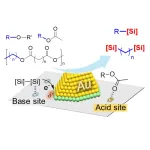(Press-News.org) A detailed "body scan" of Malaspina Glacier, one of Alaska's most iconic glaciers, revealed that its bulk lies below sea level and is undercut by channels that may allow ocean water to gain access, should its coastal barrier erode. This makes the glacier more vulnerable to seawater intrusion than previously thought and may cause it to retreat faster than predicted.
The findings, published by University of Arizona researchers in the Journal of Geophysical Research, underscore the fragility of a very large glacial system that could lead to the loss of a significant volume of ice and National Park Service land and would contribute a measurable volume to global sea level rise.
"The loss of this glacier would likely be the largest loss of ice from an Alaskan glacier within this century," said lead study author Brandon Tober, a doctoral student in the UArizona Department of Geosciences.
The area in front of Malaspina Glacier, a permafrost zone with pure ice beneath the surface, is "wasting away" in the face of rising global temperatures, Tober said. Permafrost refers to ground that remains frozen for two or more years.
"As this coastal barrier erodes and gives way to large lagoons, primarily through the collapse of ice cliffs, ocean water may eventually gain access to the glacier," Tober said. "Once it gets to the front of the glacier, it may melt the ice even faster and initiate the glacier's retreat."
Forming an expansive ice sheet located right on the shore of southeast Alaska, Malaspina is the world's largest piedmont glacier, a type of glacier that flows from steep mountains onto a broad plain, essentially forming a "pancake of ice" that spills out onto a broad coastal plain from the St. Elias Mountains. A thin land barrier separates the glacier from the relatively warm waters of the Gulf of Alaska. Historical satellite imagery shows these water bodies expanding over time, forming a lagoon system directly in front of the glacier over the past few decades.
Traditionally, researchers rely on mathematical models to gauge the thickness of glaciers, Tober said, but they vary widely in their ability to accurately predict the thickness of glaciers. These models often rely on measurements of how fast the glacier moves across the surface to make predictions about the glacier's depth, similar to the way a river's water flow rates are used to gain insights about its depth and the shape of its bed.
"We know that glaciers in Alaska are melting and thinning rapidly in many places, but we don't accurately know how thick they are, and therefore we can't accurately predict future mass loss," Tober said. "If we don’t know the thickness and bed topography, we can't accurately model their future evolution."
To gain a better idea of Malaspina's future, the researchers needed to get a detailed "body scan" of its shape and thickness. To do this, Tober's research group used the Arizona Radio Echo Sounder, or ARES, an instrument designed and built by a team led by Jack Holt, a professor at the UArizona Lunar and Planetary Laboratory and Department of Geosciences, and one of the paper's co-authors. Holt's research group specializes in using geophysical research methods, primarily radar, to study features on Earth and Mars.
ARES was mounted in an airplane as part of Operation IceBridge, a NASA-funded mission tasked with measuring annual changes in the thickness of glaciers, sea ice and ice sheets in Greenland, Alaska and Antarctica from airplanes between 2009 and 2021.
While the plane crisscrossed the vast, icy expanse, its ice-penetrating radar "X-rayed" the glacier, resulting in a full "3D body scan" of the glacier and underlying bedrock. The measurements revealed that Malaspina glacier sits largely below sea level and is cut by several channels at its bed that extend at least 21 miles from where the glacier meets the shore up toward its source in the Saint Elias Mountains.
The combination of the glacier's location with respect to the sea level and the continued loss of its coastal barrier may provide pathways for ocean waters to access large areas of the glacier's bed along these channels, the researchers write in their paper. Assuming this leads to large-scale shedding of ice masses and the glacier's retreat, the researchers conclude that Malaspina has the potential to contribute 560 cubic kilometers, or 134 cubic miles, of ice to the ocean. In other words, Malaspina alone could raise global sea level by 1.4 millimeters, or just under 1/16 of an inch.
"This might not sound like much, but to put this in perspective, all Alaskan glaciers combined contribute about 0.2 millimeters per year to global sea level rise – a rate that tops all other glaciated regions on Earth apart from the Greenland and Antarctic ice sheets," Tober said.
The study makes Malaspina the most extensively radar-mapped glacier in Alaska, according to Tober's team. While glaciers in other parts of the world have been mapped to similar levels of detail, their Alaskan counterparts have eluded accurate measurements because they consist of what is known as temperate or "warm" ice.
"The glacier's crevasses often have water in them, and that makes it difficult to get radar energy down to the bed of the glacier and back up to the instrument," Tober said.
Overcoming that challenge was part of the motivation to build ARES.
The radar scans revealed that glaciological models overestimate Malaspina's volume by more than 30%. Still, the glacier, which was measured to be just over half a mile thick at its center, boasts 10 times the total volume of all the glaciers in the Swiss Alps.
"We can speculate that the channels, the big troughs beneath the glacier, are routing meltwater that comes out at the coast," Tober said.
The observed expanse of lagoons across Malaspina's foreland over the past few decades is largely what alerted a team of researchers including Holt to the fact that the coastal barrier in front of Malaspina Glacier is wasting away, raising questions about the glacier's stability. The team, which consists of researchers from the UArizona, the University of Alaska Fairbanks, the University of Montana and the National Park Service, was awarded a grant by the National Science Foundation to further investigate the potential demise of the world's largest piedmont glacier.
Sydney Mooneyham, a co-author on this paper who graduated from the UArizona School of Geography, Development and Environment, mapped the expanse of the lagoons across Malaspina's foreland over the course of about 50 years' worth of images taken by Landsat, a series of Earth-observing satellites launched to study and monitor Earth's landmasses.
Another motivation to focus on Malaspina Glacier, Tober said, came from the fact that it is located in the largest national park in the U.S., the Wrangell Saint Elias National Park and Preserve. At 13.2 million acres, it is larger than Yellowstone National Park, Yosemite National Park and the country of Switzerland combined, according to the National Park Service.
"The potential loss of Malaspina and opening of a new bay along Alaska's coastline may be the largest landscape transformation within the U.S. that we could witness during this century," Tober said, "and it may lead to the loss of up to 500 square miles of park land."
END
3D radar scan provides clues about threats to iconic Alaskan glacier
Mapping a large coastal glacier in Alaska revealed that its bulk sits below sea level and is undercut by channels, making it vulnerable to accelerated melting in an already deteriorating coastal habitat.
2023-03-18
ELSE PRESS RELEASES FROM THIS DATE:
Changes in mangrove blue carbon under elevated atmospheric CO2
2023-03-18
As one of the major blue carbon ecosystems, mangroves provide critical ecosystem services in mitigating global climate change. However, the future complex and variable climate conditions may lead to the uncertainty in trajectories of blue carbon capacity. Elevated atmospheric CO2 concentrations (eCO2) is projected to become a prominent driver to mangrove blue carbon in the future.
A group of scientists working on blue carbon reviewed studies on “changes in mangrove blue carbon under elevated atmospheric CO2” to identify the pathways for how eCO2 might influence mangrove ecosystem carbon cycling. The research is published as a review article in Ecosystem health and sustainability, ...
Study examines the link between mental health and oral health
2023-03-18
Alexandria, VA – A study examining the mental health-oral health association cross-sectionally and longitudinally was presented at the 52nd Annual Meeting & Exhibition of the AADOCR, held in conjunction with the 47th Annual Meeting of the CADR. The AADOCR/CADR Annual Meeting & Exhibition took place at the Oregon Convention Center in Portland on March 15-18, 2023.
The study, led by Alex Kalaigian of the University of California, San Francisco School of Dentistry, acquired self-reported data from the Population ...
New catalyst helps turn plastic waste into useful organosilane compounds
2023-03-18
Tokyo, Japan – Researchers from Tokyo Metropolitan University have found that gold nanoparticles supported on a zirconium oxide surface help turn waste materials like biomass and polyester into organosilane compounds, valuable chemicals used in a wide range of applications. The new protocol leverages the cooperation between gold nanoparticles and the amphoteric (both acid and base) nature of the zirconium oxide support. The result is a reaction that requires less demanding conditions, a greener method for upcycling waste.
Recycling is a big part of humanity’s solution to the global issue of plastic waste. Much ...
DOE funds next-generation Center for Bioenergy Innovation to advance renewable jet fuel
2023-03-17
The Center for Bioenergy Innovation has been renewed by the Department of Energy as one of four bioenergy research centers across the nation to advance robust, economical production of plant-based fuels and chemicals. CBI, led by Oak Ridge National Laboratory, is focused on the development of nonfood biomass crops and specialty processes for the production of sustainable jet fuel to help decarbonize the aviation sector.
The DOE announcement provides $590 million to the centers over the next five years. Initial funding for the four ...
DOE renews CABBI for five more years
2023-03-17
The U.S. Department of Energy (DOE) has committed another round of funding to the University of Illinois Urbana-Champaign to lead the second phase of its Bioenergy Research Center — one of four large-scale DOE-funded research centers focused on innovation in biofuels, bioproducts, and a clean energy future for the country.
Earlier today the DOE announced a five-year extension of funding for the Center for Advanced Bioenergy and Bioproducts Innovation (CABBI), to a total of $237.9 million for the period from 2017 to 2027. CABBI ...
Study attempts to identify bacterial indicator species of obesity and metabolic syndrome in adult and pediatric patients
2023-03-17
Alexandria, VA – A study aiming to identify biomarker species associated with obesity and metabolic syndrome (MetS) was presented at the 52nd Annual Meeting & Exhibition of the AADOCR, held in conjunction with the 47th Annual Meeting of the CADR. The AADOCR/CADR Annual Meeting & Exhibition took place at the Oregon Convention Center in Portland on March 15-18, 2023.
The study, led by Tanveer Vasdev of the University of Iowa, analyzed 208 saliva and subgingival samples from periodontally, healthy, frequency-matched patients belonging to adult and pediatric obesity and MetS. Bacterial ...
Aging | Senescence-associated exosomes transfer fibrosis to neighboring cells
2023-03-17
“This shows that SA-EXOs can serve as potent SASP mediators that activate invasive characteristics in neighboring cells.”
BUFFALO, NY- March 17, 2023 – A new research paper was published in Aging (listed by MEDLINE/PubMed as "Aging (Albany NY)" and "Aging-US" by Web of Science) Volume 15, Issue 5, entitled, “Senescence-associated exosomes transfer miRNA-induced fibrosis to neighboring cells.”
Radiation-induced fibrosis is a common side effect of radiotherapy, which is the most common ...
Sutharshan named ORNL deputy for operations
2023-03-17
Balendra Sutharshan has been named chief operating officer for Oak Ridge National Laboratory. He will begin serving as ORNL’s deputy for operations and as executive vice president, operations, for UT-Battelle LLC effective April 1. He will succeed Alan Icenhour, who is retiring this spring after serving in the role since 2021. UT-Battelle operates ORNL for the Department of Energy.
Sutharshan joined ORNL in February 2021 as the associate laboratory director for the Isotope Science and Engineering Directorate. Under his leadership, ISED has achieved remarkable growth in isotope research and development, as well as production ...
Carnegie Mellon to lead NASA Space Technology Research Institute
2023-03-17
In space travel, custom parts for vehicles such as rockets and satellites are often needed quickly to accommodate changes in design, as well as for repair and functionality purposes. Additive manufacturing is an ideal technology to meet these needs, as components can be made through a relatively short cycle of design, build, and test. However, this cycle must be continually refined in order to ensure the quality and reliability of the 3D printed parts.
A new NASA Space Technology Research Institute (STRI) led by Carnegie Mellon University seeks to shorten the cycle required to design, manufacture, and test parts that can withstand ...
DOE announces $590 million to increase bioenergy research
2023-03-17
WASHINGTON, D.C. — The U.S. Department of Energy (DOE) today announced $590 million to renew its four existing Bioenergy Research Centers (BRCs). This funding will help support the Department’s research into the next generation of sustainable, cost-effective bioproducts and bioenergy from domestic biomass resources, which is critical to reducing harmful greenhouse gas emissions, ensuring future energy security, and creating new economic opportunities in rural areas. Since their inception, the BRCs have made groundbreaking scientific contributions to and advancements ...
LAST 30 PRESS RELEASES:
University of Oklahoma researcher awarded funding to pursue AI-powered material design
Exploring how the visual system recovers following injury
Support for parents with infants at pediatric check-ups leads to better reading and math skills in elementary school
Kids’ behavioral health is a growing share of family health costs
Day & night: Cancer disrupts the brain’s natural rhythm
COVID-19 vaccination significantly reduces risk to pregnant women and baby
The role of vaccination in maternal and perinatal outcomes associated with COVID-19 in pregnancy
Mayo Clinic smartwatch system helps parents shorten and defuse children's severe tantrums early
Behavioral health spending spikes to 40% of all children’s health expenditures, nearly doubling in a decade
Digital cognitive behavioral treatment for generalized anxiety disorder
Expenditures for pediatric behavioral health care over time and estimated family financial burden
Air conditioning in nursing homes and mortality during extreme heat
The Alps to lose a record number of glaciers in the next decade
What makes a good proton conductor?
New science reporting guide published for journalists in Bulgaria
New international study reveals major survival gaps among children with cancer
New science reporting guide published for journalists in Turkey
Scientists develop a smarter mRNA therapy that knows which cells to target
Neuroanatomy-informed brain–machine hybrid intelligence for robust acoustic target detection
Eight SwRI hydrogen projects funded by ENERGYWERX
The Lundquist Institute and its start-up company Vitalex Biosciences Announces Strategic Advancement of Second-Generation fungal Vaccine VXV-01 through Phase 1 Trials under $40 Million Competitive Con
Fine particles in pollution are associated with early signs of autoimmune disease
Review article | Towards a Global Ground-Based Earth Observatory (GGBEO): Leveraging existing systems and networks
Penn and UMich create world’s smallest programmable, autonomous robots
Cleveland researchers launch first major study to address ‘hidden performance killer’ in athletes
To connect across politics, try saying what you oppose
Modulating key interaction prevents virus from entering cells
Project explores barriers to NHS career progression facing international medical graduates
Jeonbuk National University researchers explore the impact of different seasonings on the flavor perception of Doenjang soup
Two Keck Medicine of USC Hospitals named Leapfrog Top Teaching Hospitals
[Press-News.org] 3D radar scan provides clues about threats to iconic Alaskan glacierMapping a large coastal glacier in Alaska revealed that its bulk sits below sea level and is undercut by channels, making it vulnerable to accelerated melting in an already deteriorating coastal habitat.






